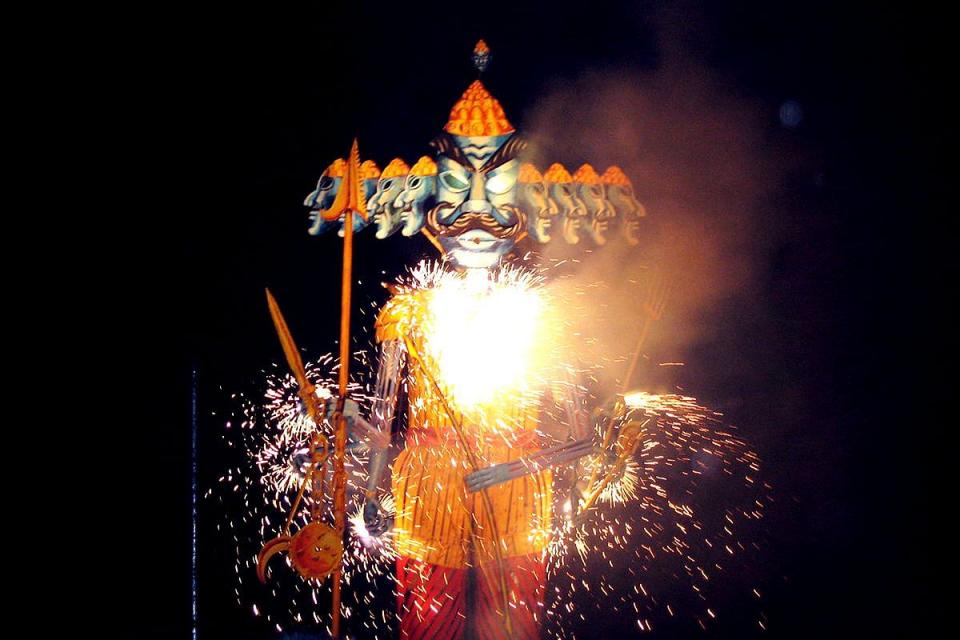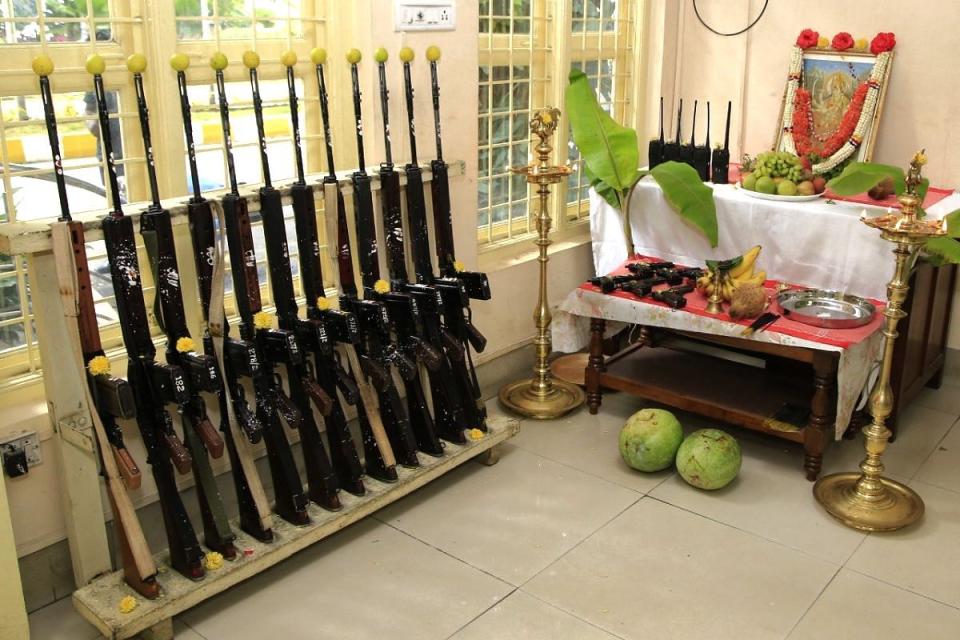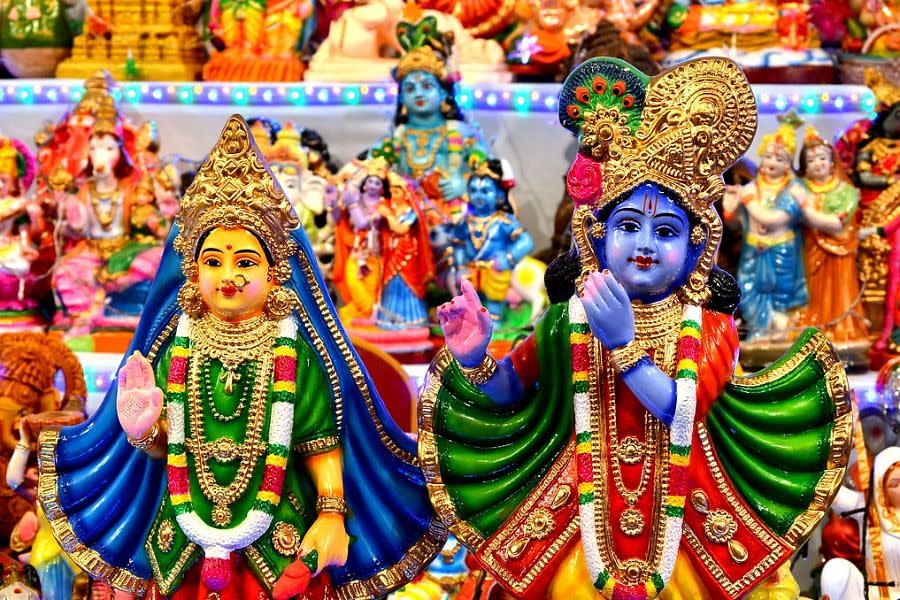Vijaya Dashmi: May We Never Forget That There's No Victory Without A Fight

Vijaya Dashami reminds us of the value of the good fight, the Dharma yuddha, which is battled again and again.
Vijaya Dashami is the day of victory. Observed on the tenth day of Ashvin masa after the nine nights of Navaratri, it is celebrated as Dasha-Hara/Dussehra in the north, Vijayadashami in the south, and Bijoya in the east. As a Bengali child growing up in the United States, I only knew of it as the day when we would call up all of our relatives and elders in India and abroad to offer our ‘Bijoyer pranam’.
There is a gathering of energies that precedes Navaratri. You can feel it in the chill of the air, in the thickening darkness as the evenings grow longer with the subsiding of summer. It starts before Navaratri, even begins on Amavasya, the night of no moon. The call of the shankha and the ringing of the bells pierces the pre-dawn darkness as Devi, Maa Durga, is roused from sleep through the chants and sonorous hymns of Mahalaya and urged to come home to visit us, her mortal family, for a few days at least.
From the first day of the moon, Pratipad, in Ashvin masa, begins the Navaratri or the Navaratra, the nine nights devoted to Devi. Many do not know that actually there are four Navaratris that occur in a year.
Sharadiya Navaratri, the one that culminates in the Vijaya Dashami that we are celebrating today, is the most prominent. Chaitra Navaratri, which takes place in the spring and culminates with Sri Rama Navamai, is also widely celebrated. The other two are gupta or secret and have special esoteric significance in terms of sadhana.
In short, Vijaya Dashami is the day of victory, the greatest day of celebration in the Hindu year.
It is a celebration of war, of dharma yuddha, the greatest metaphysical victories over the most horrific and vile of the asuras and rakshasas, of restoring Dharma age after age. It is a celebration of virility and power.
This is the day, after ten days of war, after ten days of worshipping Devi, when Sri Rama destroys Ravana. It is also the day when Sri Hanuman found Sita in the Ashoka forest in Lanka.
This is the day that Maa Durga, imbued with the strength of all of the devas who poured the entirety of their energies into Her, blazes with incandescent power and slays Mahishasura, the demon in the form of a buffalo.
It is said that a flash of lightning emerged from the mouths of Brahma, Vishnu, and Mahadeva, from which emerged Maa Durga. The strength of all the weapons of all the devas were combined and forged into the weapons she bore in her ten arms to wage war against Mahishasura. For nine days and nine nights, She fought, astride her lion. On the tenth day, on the day of Vijaya Dashami, She won.
In Durga Pujo, on Maha Ashtami, Devi assumes the form of Chamunda Devi, and at the time of the sandhi puja, the junction between Ashtami and Navami, Chanda and Munda are killed. In the Devi Mahatmyam, which Devi as Maa Kali, Maa Lakshmi and Maa Saraswati, each assumes different manifestations in a series of battles against the most terrible of asuras. Many recite this text daily or over the course of Navaratri. The final battles against Raktabeeja, Shumbha and Nishumbha are won by Devi, and the cosmic order is restored. This victory, too, is celebrated on Vijaya Dashami.
Vijaya Dashami has special significance in the Mahabharata. Following the disastrous defeat in the dice game, the Pandavas had to spend twelve years in exile in the forest and then remain incognito for one year.
After spending twelve years in the forest, the Pandavas hid their weapons in a hole in a Shami tree before entering the kingdom of Virat to complete the last year in concealment. After completing one year, on Vijaya Dashami they took back their weapons. In the battle fought later that day, Arjuna used the Sammohan astra to put the entire Kaurava army to sleep and the Pandavas emerged victorious. The tradition of Ayudha puja is related to this incident.
Originally, Ayudha puja was devoted to worshipping weapons. Nowadays, it has morphed into worshipping instruments and devices used for work or school. The custom still continues today of exchanging leaves from the Shami tree to signify goodwill and auspiciousness.
Vijaya Dashami is also treated as an auspicious day to begin one’s learning. Especially in Kerala and Karnataka, on this day, children are inducted into teachings in the arts, music, dance, and languages.


The festive spirit of Navaratri and Vijaya Dashami certainly surrounds us. It’s the ‘festival season’. There are sales. There are social gatherings where we flock gaily dressed in bright colours. There is pandal-hopping, garbha-dancing, and golu-visiting, constrained by the pandemic to some extent.
Every block in Kolkata is adorned with pandals of Maa Durga. Perhaps only in Bengal and the surrounding region is this day a bittersweet, sad one. Yes, we celebrate Ma’as glorious victory over the enemies, but it is also the day we have to bid Her adieu. Long processions accompany the clay forms of Devi into the river or other water body, where She is gently submerged to return to the elements once more. We watch until we can no longer see Her. And then we begin the vigil to await Her homecoming next year.
In southern India, homes and temples feature elaborate displays of an odd number of shelves displaying bommai-golu (in Tamil, bommai-kolu means divine presence). These dolls are of our devas and devis, or thematic representations of various events from the Puranas, or more playful displays of royal processions, court life, kitchen scenes and everyday folk life.
Traditionally, wooden figures of the bride and groom would be presented to the couple at their wedding as Marapacchi Bommai. Every year, they would be decorated with new clothes before being displayed as part of the golu. Golu are usually passed on as family heirlooms, and perhaps one new set would be purchased each year as part of the Navaratri festivities. In the evenings, women visit each other’s homes to view the golu displays and share prasadam. Often, bhajans are also sung. On Vijaya Dashami, one of the dolls is symbolically put to sleep and then the entire display is dismantled and kept away until the next year.
This is a beautiful example of the rich diversity in the breadth of traditions and customs geographically across Bharat. Yet, the underlying ethos and worldview, the spirit of Navaratri and the significance of the various observances, is the same.



I used to think of Navaratri and Durga Pujo as distinct traditions, but as my sadhana matures, I find the two integrally connected and different expressions of the same principle and spirit of reverence for Devi, who has come to visit us for a brief period of time each year. It is said that only for these few days will Shiva allow Devi to come back to Her human family with Her children, just like a bride will come back for a few days to her parents’ home every year and bring along the grandchildren.
Even as we continue to celebrate Navaratri and Vijaya Dashami as part of the ‘festive season’, I cannot help but think that there is something essential about the nature of Vijaya Dashami that we are beginning to lose. You see it in the increasing number of Maa Durga vigrahas used in the pandals of Kolkata that no longer show weapons in Her hands.
The increasing number of pandals that are more focused on political or social statements rather than the devotional and religious aspects of worshipping Maa Durga, that replace Devi with humanised depictions. You see it in the selective shaming of pashu bali / animal sacrifice that has long been part of the tradition of Devi puja. You see it in the increased metaphorisation of texts like the Devi Mahatamyam, treating the asuras and the war as allegorical only, where the asuras just represent negative emotions like anger and ego.
The desacralisation of Durga Pujo, of the rites of Navaratri and Vijaya Dashami, is a desecration of Devi.
There are stories in old Bengal of how Maa’s sword would twirl in the air during the crescendo of the rites. This is the real spirit of Navaratri and Vijaya Dashami, this celebration of the martial might of Devi, which is needed for the upholding of Dharma.
But we have become reluctant to fight, phobic against anything suggestive of martial strength. We are consumed by this misconception that to be weak is to be virtuous, that we must pretend to be sattvic and shun rajas as something negative, that spirituality is something delicate and pretty, that we are somehow above the fray and cannot bring ourselves to worship the bloodthirsty and the fierce, that to do so would be primitive.
All of this is nothing but gross ignorance and tamas.
Vijaya Dashami reminds us of the value of the good fight, the Dharma yuddha, which is battled again and again. It is the striving, the sacrifice, the cultivation of shakti and strength to rise to the challenge of confronting the adharmic forces who stand before us; it is this sadhana that is our work on this earth, in this lifetime. There is no victory without that fight, without that work and struggle.
When we chant Chandi Path, we imbue ourselves with a few drops of the shakti of Devi, enough to make us invincible in our quests so long as we are on the side of Dharma. When we remove the weapons from Devi’s arms, we weaken ourselves. When we read the Ramayana, the Devi Mahatmyam, the Mahabharata, we rouse within ourselves the courage and will to stand for Dharma and protect ourselves and the innocent.
Every Hindu, every person who cares for loka sangraha, the wellbeing of all sentient beings and all life forms, every person who cares about the upholding of Dharma, should on this day, make a prostration to Devi and seek to cultivate within the spirit of Vijaya, of the hard-earned victory that comes from fighting with all our might the good fight.

